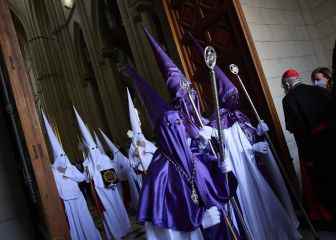The Holy Week as we knew it before the coronavirus pandemic is back. After two years of COVID restrictions, the processions return to how they were, after capacity was eliminated and the mandatory use of the mask. During this week the streets of Spanish towns and cities will once again witness the processions of the penitents.
In these processions, the symbology of the brotherhoods of brotherhoods is a whole world which has its own meaning. Among the most striking that we can find are the colors worn by the ‘brothers’. Traditionally black was the most common, both to dress the Dolorosa and for the penitents who accompanied them. But over time the amalgamation of colors has been spreading, each one with its meaning.
what each color means
Traditionally, each color has been associated to refer to different moments of the life of Jesus: before, during and after his sacrifice on the cross. The Mexican researcher Eulalio Ferrer, in his book The languages of color, explains that in the year 1200 Pope Innocent III codified the symbolism of each color. Later, as explained The debatewere revalidated by Pius V. They were, in the first instance, white, red, green and purpleto which were later added the pink, yellow, gold and blue.
The traditional black and purple
They are among the most representative in this festivity, both in the hoods as in the tunics of the Nazarenes of different brotherhoods throughout Spain. black represents mourning, mourning, so it is one of the most common on Good Friday. While, purple is Lentpenance and vigil.
the purity of white
In the Christian tradition has to do with purity, joy and light. Very typical also of other festivities such as Easter. It is commonly used for represent the risen Christbut also more prominently on Palm Sunday, which recalls the entry of jesus into jerusalem. It is also a typical color of offerings.
the red blood
symbolizes the blood shed by Jesus Christ, alluding to his love. For this reason, its presence in the carnations to decorate the steps is also typical.
blue, green and crimson
Blue is the color of the Immaculate Conceptionand is usually present especially in brotherhoods with Marian dedication. Green, meanwhile, symbolizes hope. and refers to the expectation of the Virgin. Finally, the shades in crimson are those destined for cardinal orders.
